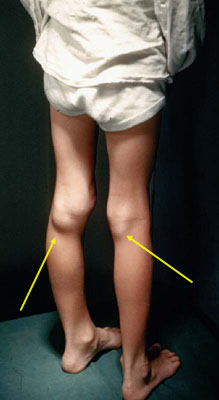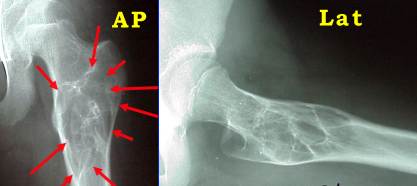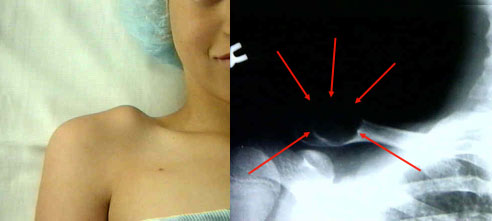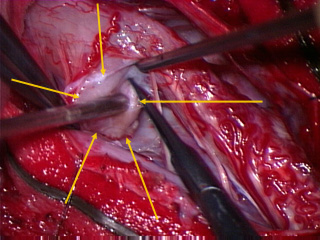Cysts & Ganglions
![]()
There is a mixed bag of mostly unrelated entities which have in common a fluid filled something. Often, they present as masses, thickenings, or tumors and scare the dickens out of people.
Ganglions & Baker's Cysts
Joints are lubricated. The lubricant is a very slippery and thick (like syrup) fluid. If the joint capsule (the flexible but tough casing of the joint, like cheeks to the mouth) - if that capsule has a tiny hole in it, the fluid being thick isn't too likely to pour out into the tissues outside the joint. But, under vigorous activity and thus high hydraulic pressure, some will be forced out. The body will recognize the leak and wall it off. But if the wall isn't strong enough, it will inflate like a balloon. That balloon does not have the pressure to drive the thick fluid back into the joint - except very slowly. Sometimes, especially in certain locations where tendons press a certain way, the opening behaves like a one way valve.
 These balloons can feel very firm, even hard. Typically they are rubbery. They are called ganglions (just to confuse everybody as the name really makes no sense at all). The
most common ones are on the back (hairy side) of the wrists. Baker's Cysts are just ganglions found on the backs of knees. They are occasionally seen at the ankles and even in the fingers.
These balloons can feel very firm, even hard. Typically they are rubbery. They are called ganglions (just to confuse everybody as the name really makes no sense at all). The
most common ones are on the back (hairy side) of the wrists. Baker's Cysts are just ganglions found on the backs of knees. They are occasionally seen at the ankles and even in the fingers.
A simple diagnosis and treatment is to simply hold the joint still. A cast will cure most ganglia by stopping the hydraulics that inflate them. As they shrink, the math of fluid pressure in containers kicks in. The smaller the diameter, the less the wall pressure (has to do with surface area vs. cubic volume ratios). Most ganglia, given the on again-off again activities of kids, will just up and go away during a lull. The more active kids may not get that relief. When casts are used, about four weeks are needed - maybe more. Sometimes you can cut the down time by draining the cyst. But it is hard to totally dry it out with a needle so some immobility helps assure it stays away. Smashing the wrist ganglia with bibles harkens back to the days when the bibles were NOT ILLUSTRATED and were soft covered and light. A current bible can do real damage!
The set up for ganglia is common in young children. Older folks may get them as a result of making too much joint fluid (torn cartilage, or rheumatism). A Baker's cyst bursting can drop a large amount of fluid that must be removed. The chemistry used to remove that fluid inflames and may be misinterpreted as phlebitis. This is rare in kids, though common in adults.
Occasionally a cyst will press its way into a muscle and look a whole bunch like a nasty tumor. Nowadays, MRI makes wrong call less likely.
Bone Cysts
 |
 |
When a bone cyst aggressively expands, it may well be under the driving force of blood pressure. Above is a rapidly expanding cyst rather typical of aneurysmal bone cyst. They typically have a feeding artery and bleed like crazy (requiring certain surgical tricks that go beyond just scraping out a cyst).
Other Weird Ones
 |
Just to show how complicated things can be, we are looking into the opened spinal canal of a new born only days old. This is at the level of the top of the shoulder blades. The spinal cord is covered in a writhing surface of blood vessels. It runs from top left to lower right in this image. You can see nerves coming out from the sides like legs on a caterpillar. A cyst (a neurenteric cyst) is pointed out deep to the spinal cord which is being gently retracted as the cyst is teased out. The cyst is lined with stomach-like cells and makes acid. It thinks it is a piece of gut. Go to the embryology section and notice that the gut layer (endoderm) is separated from the neural layer (ectoderm) by a middle layer. If a small defect in that separation happens, then gut tissue can wind up in the neural structure.
The nurses noticed that a robust baby suddenly lacked leg power. A quick diagnosis and removal led to return of function.
The above is shown only to illustrate how complex and varied things can be in medicine. Tinker Toys we're not.